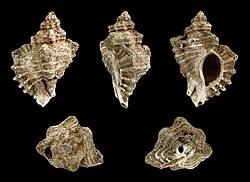
Back بوابة:علم الأحياء القديمة Arabic Portal:Paleontologia Catalan Portail:Paléontologie French Portale:Paleontologia Italian Portal:Paleontology Malay Portaal:Paleontologie Dutch Portal:Paleontologia Polish Portal:Paleontologia Portuguese Портал:Палеонтология Russian Портал:Палеонтология Tatar
|
The Palaeontology Portal
Introduction Paleontology (/ˌpeɪliɒnˈtɒlədʒi, ˌpæli-, -ən-/ PAY-lee-on-TOL-ə-jee, PAL-ee-, -ən-), also spelled palaeontology or palæontology, is the scientific study of life that existed prior to the start of the Holocene epoch (roughly 11,700 years before present). It includes the study of fossils to classify organisms and study their interactions with each other and their environments (their paleoecology). Paleontological observations have been documented as far back as the 5th century BC. The science became established in the 18th century as a result of Georges Cuvier's work on comparative anatomy, and developed rapidly in the 19th century. The term has been used since 1822 formed from Greek παλαιός ('palaios', "old, ancient"), ὄν ('on', (gen. 'ontos'), "being, creature"), and λόγος ('logos', "speech, thought, study"). Paleontology lies on the border between biology and geology, but it differs from archaeology in that it excludes the study of anatomically modern humans. It now uses techniques drawn from a wide range of sciences, including biochemistry, mathematics, and engineering. Use of all these techniques has enabled paleontologists to discover much of the evolutionary history of life, almost back to when Earth became capable of supporting life, nearly 4 billion years ago. As knowledge has increased, paleontology has developed specialised sub-divisions, some of which focus on different types of fossil organisms while others study ecology and environmental history, such as ancient climates. (Full article...) Selected article on the prehistoric world and its legacies
Parasaurolophus (meaning 'near crested lizard') was a genus of ornithopod dinosaur from the Late Cretaceous Period of what is now North America, about 76-73 million years ago. It was a herbivore that walked both as a biped and a quadruped. Three species are recognized: P. walkeri (the type species), P. tubicen, and the short-crested P. cyrtocristatus. Remains are known from Alberta (Canada), and New Mexico and Utah (United States). It was first described in 1922 by William Parks from a skull and partial skeleton in Alberta.
Parasaurolophus is a hadrosaur, part of a diverse family of Cretaceous dinosaurs known for their range of bizarre head adornments. This genus is known for its large, elaborate cranial crest, which at its largest forms a long curved tube projecting upwards and back from the skull. A similar crest is found on Charonosaurus from China, which may have been its closest relative. The crest has been much discussed by scientists; the consensus is that major functions included visual recognition of both species and gender, acoustic resonance, and thermoregulation. It is one of the rarer duckbills, known from only a handful of good specimens. (see more...) Did you know?

General images -The following are images from various paleontology-related articles on Wikipedia.
Selected article on paleontology in human science, culture and economics
Jurassic Park III is a 2001 American science fiction adventure monster film. It is the third installment in the Jurassic Park franchise and a sequel to the 1997 film The Lost World: Jurassic Park. It is the series' first film that was not directed by Steven Spielberg nor based on a book by Michael Crichton (though numerous scenes in the film were ultimately taken from Crichton's novels Jurassic Park and The Lost World). The film takes place on Isla Sorna, off Central America's Pacific coast, the island featured in the second film, where a divorced couple has tricked Dr. Alan Grant into going in order to help them find their son.
After the success of Spielberg's Jurassic Park, Joe Johnston expressed interest in directing a sequel, a film adaptation of The Lost World. Spielberg instead gave Johnston permission to direct the third film in the series, if there were to be one. Production of Jurassic Park III began on August 30, 2000. Upon its release, the film received mixed reviews, with many praising the visual effects and action scenes but finding the plot clichéd and unoriginal. Despite being less well-received than the previous films, Jurassic Park III was a box office success, grossing $368 million worldwide. (see more...) On this day...
New Insights into Non-Avian Dinosaur Reproduction and Their Evolutionary and Ecological Implications: Linking Fossil Evidence to Allometries of Extant Close Relatives Jan Werner, Eva Maria Griebeler published 21 Aug 2013
Selected image
CategoriesTopicsGeneral - Paleontology - Fossil - Evolution - Extinction Quality ContentFeatured paleontology articles
- Achelousaurus
- Acrocanthosaurus
- Albertosaurus
- Allosaurus
- Amargasaurus
- Ankylosaurus
- Apatosaurus
- Archaeopteryx
- Baryonyx
- Carnotaurus
- Catopsbaatar
- Ceratosaurus
- Chicxulub Crater
- Compsognathus
- Cretaceous–Tertiary extinction event
- Daspletosaurus
- Deinocheirus
- Deinonychus
- Deinosuchus
- Dilophosaurus
- Dinosaur
- Diplodocus
- Dromaeosauroides
- Edmontosaurus
- Elasmosaurus
- Giganotosaurus
- Gorgosaurus
- Herrerasaurus
- Iguanodon
- Istiodactylus
- Lambeosaurus
- List of dinosaur genera
- Majungasaurus
- Massospondylus
- Megalodon
- Nemegtomaia
- Nigersaurus
- Opisthocoelicaudia
- Paranthodon
- Parasaurolophus
- Plateosaurus
- Psittacosaurus
- Seorsumuscardinus
- Spinosaurus
- Stegosaurus
- Stegoceras
- Styracosaurus
- Tarbosaurus
- Thescelosaurus
- Triceratops
- Tyrannosaurus
- Velociraptor
Things you can doCurrent Paleontology FACs - None yet... WikiProjectsRelated portalsAssociated WikimediaThe following Wikimedia Foundation sister projects provide more on this subject:
Discover Wikipedia using portals |
© MMXXIII Rich X Search. We shall prevail. All rights reserved. Rich X Search








































